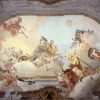In the winter of 1757, the wedding between Ludovico Rezzonico and Faustina Savorgnan took place. For the occasion, the row of rooms along the san Barnaba canal, intended as the spouses’ reception apartment, was frescoed.
In this circumstance, Giambattista Tiepolo was also present. Helped once more by Girolamo Mengozzi, he painted the Nuptial allegory on the ceiling of this room in just 12 days. Pairs of satyrs painted by Tiepolo’s son Giandomenico are leaning against a fake ochre and green marble parapet, and beyond this is an architectural structure, ending a balustrade which opens onto the sky. The two spouses are presented to the viewer riding on Apollo’s chariot; they are preceded by the blindfolded Cupid, while some allegorical figures surround the main group. Among these we can recognise: Fame, blowing her trumpet; the Graces sitting on a cloud just under the wedding chariot; Truth with the sun in her hand; and Merit, a bearded old man crowned with laurels with St. Mark’s lion at his feet and holding a banner with the coats-of-arms of the wedding couple’s families. Varying the points of view for the arrangement of the figures, the painter creates a dynamic, plausible image where even the paradoxical appears as concrete. Only Giambattista Tiepolo’s imagination and skill would have been able to imagine the couple’s arrival directly on the chariot of the sun, and to render it credible at the same time.
This room also contains the Portrait of Carlo Rezzonico, son of Giambattista, the first owner of the palace, and the uncle of Ludovico, who became pope in 1758 with the name of Clement XIII. The painting is by Anton Raphael Mengs, the philosopher painter who was the friend of Winckelmann and the first protagonist of Neoclassical painting. Reportedly, the painting was originally intended to be displayed in the family palace in Venice, but shortly after its execution it was moved to Rome, where the Pope’s nephew, Cardinal Abbondio Rezzonico, had taken up residence.
On the right wall is the small chapel built in the second half of the 18th century. Framed by an elegant rococo decoration with gilded stuccowork against a white background, the painting of the Madonna and Saints is by Francesco Zugno, a pupil of Giambattista Tiepolo. The glass cases lining the walls of the room display porcelain from different European manufactories from the collection of Marino Nani Mocenigo.


